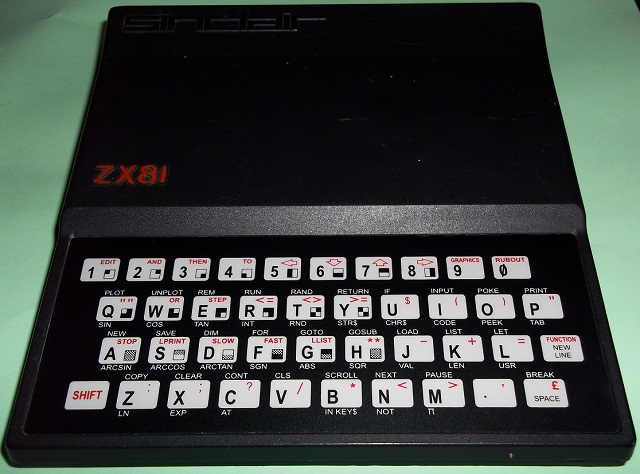

Sinclair ZX World
Resources for the Sinclair ZX80 and ZX81 Home Computers
 The
Sinclair ZX80
was one of the first real home computers - it
was supplied in kit form to home electronics enthusiasts for just £99.95 and was
fairly
easy to build up into a fully working computer, complete with built in
BASIC
interpreter, Z80 processor and a massive 1K RAM (random access
memory).
The
Sinclair ZX80
was one of the first real home computers - it
was supplied in kit form to home electronics enthusiasts for just £99.95 and was
fairly
easy to build up into a fully working computer, complete with built in
BASIC
interpreter, Z80 processor and a massive 1K RAM (random access
memory).
Interestingly, the computer contains no custom chips with the display being generated using just TTL logic.
The ZX80 was the first in a line of computers from Sinclair Research Limited (then known as Science of Cambridge) and was developed by the British inventor, Sir Clive Sinclair. It was heralded as the first computer available for less than £100.
The Sinclair ZX80 was an all-white computer first released in 1980 with the case designed by Rick Dickinson. Originally a matching white power supply and RAM pack was available, although later black versions of these (bearing the marking Sinclair ZX80) were released. The white PSU and RAM pack are especially rare, mainly due to a large number of returns of the white RAM pack.
The display was black and white, with block characters only available - there was no sound built into the computer, and the keyboard was a touch sensitive layer, which included the ability to enter commands into the computer by just pressing a single key (or combination of keys).
One of the main perceived drawbacks with the ZX80 was that every time you press a key, the computer jumps into FAST mode whereby the screen is blanked for a few milliseconds in order to allow the Z80 processor to perform the instructions linked to the key command as quickly as possible. However, even this issue has been addressed over the years with the release of flicker free games for the Sinclair ZX80.
Unfortunately, items specifically aimed at the ZX80, are very difficult to find, especially in view of the fact that Sinclair released the more popular ZX81 the following year.
Second hand prices for the Sinclair ZX80 remain high, and various items have been produced to help keep these machines working and in good condition, with various clones having also been produced.
 The
Sinclair ZX81 was the first popular home computer and was the
computer which launched the home computer industry -
it came
either as a kit for just £49.95 or ready-assembled for £69.95.
The
Sinclair ZX81 was the first popular home computer and was the
computer which launched the home computer industry -
it came
either as a kit for just £49.95 or ready-assembled for £69.95.
The ZX81 came complete with built in BASIC interpreter, Z80 processor and a massive 1K RAM (random access memory). As with the ZX80, users could simply connect the ZX81 to a television at home, meaning that special monitors were not required.
The Sinclair ZX81 was the first computer to adopt the Sinclair black colour and originally came with a 700mA PSU, which had the plug incorporated into the power supply unit (akin to the earlier ZX80 PSU).
However, when Sinclair released its own add-on thermal Sinclair ZX Printer for the Sinclair ZX80, ZX81 and Spectrum computers, it was found that the original ZX80 and ZX81 power supplies were insufficient and the larger 1.2A PSU was released (this power supply unit appears half-way along the cable).
Again, the ZX81 was designed to be simple to use with a touch sensitive keyboard, black and white display with block characters and no sound.
A host of add-ons were produced for the Sinclair ZX81 both by Sinclair and other manufacturers, including a 16K RAM pack (notorious for crashing due to wobble). Later add-ons allowed the use of high resolution graphics, colour, sound and even games in high resolution were produced, using a software only solution!
The Sinclair ZX81 continues to be dear to many people's hearts and the past few years has seen the release of new hardware and software (including classic games, such as Boulder Logic and Panic), much of which uses one of several techniques to produce hi-resolution graphics on screen.
2012 even saw the release of several high resolution games which can run on the standard ZX81 in just 1K.
Some software even manages to generate sound using the original hardware, although much better quality sound is generated using an add-on interface with an AY-3-8910 chip.
(c) RWAP Software